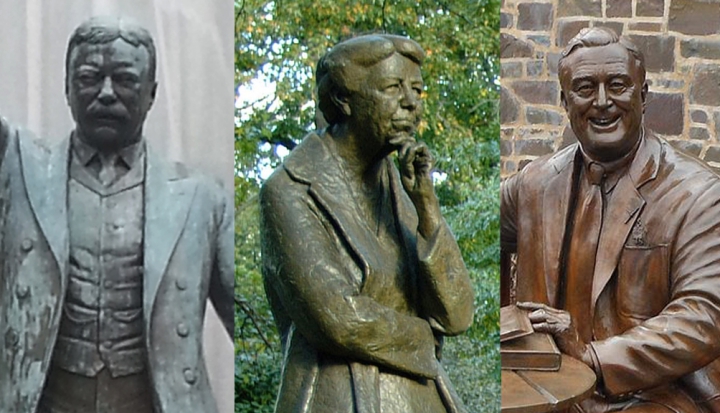In Ken Burns’ powerful new documentary, Theodore, Franklin, and Eleanor need no embellishing.
Earlier this year President Obama admitted in an interview with Ellen DeGeneres that he watches the Netflix thriller House of Cards. The show follows Washington power couple Frank and Claire Underwood (played by Kevin Spacey and Robin Wright) as they scheme their way up the political ranks, all the way to the White House.
Having binge-watched both seasons, I wondered if there was any truth to the show’s depiction of Washington. Obama put that notion to rest, noting that “life in Washington is a little more boring than displayed on the screen,” and that a typical workday for him “wouldn’t make very good television.” It’s probably for the best.
And yet I might argue after watching Ken Burns’ latest work, The Roosevelts, that the real lives of presidents are compelling enough. The 14-hour documentary, which aired on PBS this past September, is some of the most powerful storytelling I’ve ever seen on television. Intense personal stories set The Roosevelts apart from Burns’ other films. He portrays Theodore, Franklin, and Eleanor Roosevelt as real, messy human beings.
I recently attended an event at which Burns and House of Cards creator Beau Willimon discussed their respective projects. Burns said he approached making The Roosevelts with the same rules as good TV storytelling—such as showing humans with all their flaws and contradictions. In that sense, Theodore Roosevelt, or “TR,” was practically made for the big (or small) screen. Born into a wealthy New York family, he thrust himself into public service as a friend of the working poor, though most people of his class considered politics beneath them.
Burns and his longtime collaborator Geoffrey Ward ably show how TR’s manic drive to achieve (at the age of 42 he became the youngest president in American history) was fueled by a lifelong battle to outrun depression. He was constantly in motion. When his wife and mother died on the same day, he decamped to the Dakotas to reinvent himself as a cattle rancher.
Frankly, TR is a polarizing figure. He comes across as a hero when breaking up greedy corporations, fighting for consumers’ rights, and creating the National Parks Service. But he had a disturbing appetite for war and a pathological need to prove his manhood. In 1912 he was shot just before he was scheduled to deliver a speech. Showing off his bloody wound to a shocked audience, he continued to speak for an hour before agreeing to be treated by a doctor.
Even the strongest can’t outrun time, and one of the film’s most poignant scenes depicts an aged TR at the end of his career. He is significantly diminished in health and vigor, struggling to accept his waning influence on American life. Historian David McCullough calls him a “high intensity lightbulb that burned out quickly”—an apt metaphor for our fleeting days.
Of course, TR wouldn’t be the last Roosevelt to shape history. The second half of The Roosevelts focuses on his fifth cousin, Franklin Delano Roosevelt (FDR), and his wife, Eleanor. Their lives were also marked by adversity, and, like their famous relative, they confronted those fears in their own ways.
Like Theodore, Franklin Roosevelt was born into immense privilege. His doting mother bathed him until he was 9—not an auspicious start for a future president. The film’s moving account of his midlife bout with polio renders him a more sympathetic and interesting character. Hardened by his struggle with disability, he served an unprecedented four terms as president, guiding the nation through two of its greatest crises: the Great Depression and World War II.
FDR’s famous fireside chats over the radio reassured fearful Americans that they not only had a leader, but a friend. Struggling Americans, however, may have had a better friend in Eleanor Roosevelt. I admired how she was constantly in FDR’s ear, urging him to help disenfranchised Americans, including African Americans. And, like her, I was often frustrated by his willingness to go only so far.
Like the fictional Underwoods, Franklin and Eleanor had a complicated marriage, and, thankfully, FDR’s extramarital affairs aren’t glossed over. They devastated Eleanor, who as a child was shunned by her mother for her looks. All her life she worried that no one would ever love her.
But she, like Burns, knew that actual people are inscrutable. Looking back on her husband’s infidelity, she said, “I had to face certain difficulties until I decided to accept the fact that a man must be what he is, life must be lived as it is.” The film makes a convincing case that those disappointments gave her the necessary courage to forge a life of her own.
It wasn’t until after FDR’s death in 1945 that Eleanor Roosevelt could fully flourish as a leader, and this era brings The Roosevelts to a satisfying close. What she accomplished in those years was remarkable, namely the key role she played in drafting the Universal Declaration of Human Rights. Despite Burns’ efforts to credit her, Eleanor’s life seems to demand its own movie-length treatment. By the end, I missed her as if she were family.
The real lives of the Roosevelts may not rise to House of Cards levels of intrigue, but Burns succeeds at bringing his subjects into vivid color. We can only understand what they did by knowing who they were, and The Roosevelts shows us what made these American giants tick.
What makes it so fun to watch is the same premise that underlies the best TV shows and movies: People are innately fascinating. When human lives are honestly portrayed with all their complications and failures, the product is often more interesting than anything Hollywood could dream up. Real life, it turns out, often needs no embellishment.
This column appeared in the December 2014 issue of U.S. Catholic (Vol. 79, No. 12, pages 40-41).
Image: Wikimedia cc, Public domain












Add comment